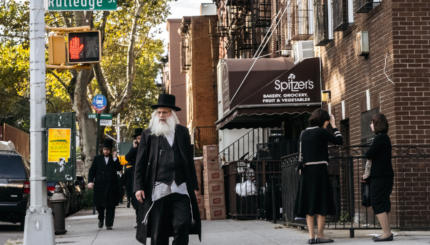The issue of body piercing is presenting no small challenge to many a contemporary parent. For what has long been an issue of only ear piercing and limited to women, has now been extended to men and to almost every imaginable part of the body capable of being pierced.
While many of us may not understand why anyone would want to pierce some of the parts of the body, the question before us asks if such acts render one unfit for ritual inclusion or burial.
Body Piercing in the Bible and Talmud
Ear piercing is mentioned in the Bible in several contexts. The most familiar refers to a Hebrew slave who was to be freed in the seventh year of servitude but declares his love for his master and refuses to go free: “…his master shall take him before God. He shall be brought to the door or the doorpost, and his master shall pierce his ear with an awl; and he shall then remain his slave for life” (Exodus 21:6).
There is some disagreement in the Gemara (Babylonian Talmud [BT], Kiddushin 21b) as to how permanent this piercing of the slave’s ear was supposed to be. But our piercing is clearly of a non-permanent nature and its intent is purely decorative. This type of piercing was also known in the Bible:
With your help, My Jewish Learning can provide endless opportunities for learning, connection and discovery.
“I inquired of her, ‘Whose daughter are you?’…And I put the ring on her nose and the bands on her arm” (Genesis 24:47).
“Aaron said to them, ‘Take off the gold rings that are on the ears of your wives…'” (Exodus 32:2).
“I decked you out in finery…I put a ring in your nose, and earrings in your ears…” (Ezekiel 16:11. See also Exodus 35:22, Numbers 31:50, Judges 8:24, Isaiah 3:21).
This is also well documented in rabbinic times: “…small girls may go out [on Shabbat] with threads or even chips in their ears” (Mishnah Shabbat 6:6).
It also appears that there may be references to male ear piercing in the Talmud as well. In a discussion in the Talmud regarding the wearing of jewelry on Shabbat, the Gemara states: “A tailor must not go out with a needle stuck in his garment, nor a carpenter with a chip in his ear.…”
Rashi refers to a custom in his day for men to wear earrings that were signs of their respective trades (Rashi on BT Shabbat 11b; he explains that it was the custom of tradesmen to wear signs of their trade in the form of earrings so that when they walked in the marketplace people would know their particular trade and could hire them).
While Rashi seems to understand this chip as being tucked behind the ear, [early 20th century Reform scholar] Jacob Lauterbach (in his “Responsa on Pierced Ears,” CCAR Yearbook, September 1983) understands it as an example of piercing. The same expression, a “chip in the ear,” is found in the above-cited Mishnah of Shabbat (Mishnah Shabbat 6:6) and clearly refers to piercing. It was also a well-established custom in European countries well into the Middle Ages for tradesmen to wear pierced earrings of the symbol of their trade.
The surgical process of piercing both the ear and the nose seems to be well documented in the Bible and the Talmud. While there are many today who would find the biblical custom of nose piercing unacceptable, there are apparently many young people today who find it attractive. And while some are uncomfortable with men having their ears pierced, even this has a precedent in traditional literature. The only issue that seems to direct this matter is the fashion of the day. It is hard to argue from a halachic [Jewish legal] perspective that there is a substantive difference between the non-permanent piercing of the ear for fashion purposes and the non-permanent piercing of the eyebrow, navel or even nipple. The lack of aesthetic appeal to many of us is hardly a halachic consideration.
Health, Modesty and Being in the Image of God
There are some legitimate concerns that could and should be raised. There is a concern that an inappropriate procedure or lack of proper hygiene involved in the piercing of a clitoris, nipple or scrotum, for example, could lead to an infection with significant consequences. Piercing should be done only by those medically qualified to address these concerns.
In addition there is the issue of b’tzelem Elohim (human creation in the image of God) and tzniut (modesty). With respect to the traditional Jewish value of tzniut, one has to wonder, if “private” parts of the body are being pierced for fashion purposes, [whether] the intent is to keep that private part private. While there may be no prohibition against such body piercings, they must be placed in the larger context of tzniut, which remains an important Jewish value.
And, while ear piercing seems to be a fairly benign practice, there comes some point where multiple piercing of the body, however fashionable, begins to challenge our concept of b’tzelem Elohim. It seems to me that Jews sufficiently educated and sensitive to the concepts of tzniut and b’tzelem Elohim will limit themselves appropriately regarding body piercing.
Beyond the Letter of the Law
I am reminded of a d’var Torah (Torah commentary) Rabbi David Weiss Halivni [a contemporary Talmudic scholar] once gave at the Jewish Theological Seminary regarding the permissibility of animal hunting for pleasure by Jews, quoting a teshuvah [responsum] by Rabbi Ezekiel ben Judah Landau (Noda’ Biyhuda,” Yoreh De’ah 10). After taking some time to explain why it was indeed permitted by the Torah, he concluded by saying, “Yes, it is permitted, but what kind of a Jew would want to hunt for pleasure?” While not nearly as serious an issue as hunting, one can only wonder what questions about body piercing and tattooing tell us about our contemporary community.
Ultimately this seems to be a matter of fashion which will pass with time. But until then, we should strengthen the sense of tzniut, which should guide our fashion choices and underscore our belief that we are created b’tzelem Elohim in an attempt to balance contemporary pressures. But, I see no basis for any sanctions on those who engage in such fashions, certainly not of the magnitude of refusing burial in a Jewish cemetery or refraining from including them in any synagogue practices.
Not Prohibited, But Raises Concerns
Body piercing is not prohibited, although legitimate concerns regarding tzniut and other traditional Jewish values should be taken into consideration and guide one’s choices. At all times a Jew should remember that we are created b’tzelem Elokim. We are called upon to incorporate this understanding into all our decisions.
Reprinted with permission of the Rabbinical Assembly.
Shabbat
Pronounced: shuh-BAHT or shah-BAHT, Origin: Hebrew, the Sabbath, from sundown Friday to sundown Saturday.
Talmud
Pronounced: TALL-mud, Origin: Hebrew, the set of teachings and commentaries on the Torah that form the basis for Jewish law. Comprised of the Mishnah and the Gemara, it contains the opinions of thousands of rabbis from different periods in Jewish history.



